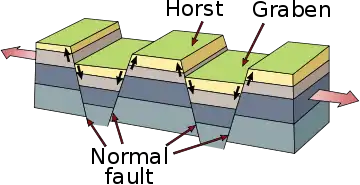Horst and graben
In geology, horst and graben refer to regions that lie between normal faults and are either higher or lower than the area beyond the faults. A horst represents a block pushed upward relative to the blocks on either side by the faulting, and a graben is a block generally long compared to its width that has been lowered relative to the blocks on either side due to the faulting. Horst and graben are formed when normal faults of opposite dip occur in pair with parallel strike lines. Horst and graben are always formed together. Graben are usually represented by low-lying areas such as rifts and river valleys whereas horsts represent the ridges between or on either side of these valleys.

The Condroz and Ardennes regions of Wallonia are good examples of a succession of horst and graben.
The Satpura Range is a horst in India and is flanked by Narmada Graben in the north and much smaller but parallel Tapi Graben in the south.[1][2]
See also
References
- Valdiya, K. S. (2015-11-26). The Making of India: Geodynamic Evolution. Springer. ISBN 9783319250298.
- Valdiya, K.S.; Sanwal, Jaishri (2017-01-01). "Satpura Horst and Narmada–Tapi Grabens". Neotectonism in the Indian Subcontinent - Landscape Evolution. Developments in Earth Surface Processes. 22. pp. 237–247. doi:10.1016/B978-0-444-63971-4.00010-4. ISBN 9780444639714. ISSN 0928-2025.